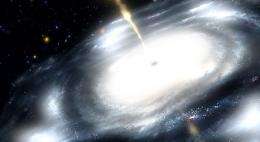June 11, 2012 weblog
Researchers suggest speedy growth of early black holes may have inhibited the growth of others

(Phys.org) -- A trio of astrophysicists is theorizing that the reason that there is not a larger variety of black hole sizes in the known universe is because those that were spawned first heated up the universe to the extent that it stunted the growth of others. The team members: Takamitsu Tanaka, Rosalba Perna and Zoltán Haiman outline their ideas in their paper they’ve uploaded to the preprint arXiv. In it they suggest that the black holes that formed soonest after the Big Band, pulled in enormous quantities of gas and emitted huge amounts of x-rays; enough they say to heat up the universe, preventing other black holes from growing larger.
The current thinking regarding black holes is that unfathomably huge black holes that weighed billions of times as much as our sun, came into existence before the universe was even a billion years old. One snag to this idea however, has been that logically speaking, there should have also been black holes of many sizes, from the super huge, to the relatively small. And because that doesn’t appear to have happened, the thinking goes, something must have stunted the growth of other black holes leaving most of them very small in comparison. That something, the research trio suggests, was the speedy development of just a few early black holes that started out very small (just tens of times the mass of our sun) but then grew very rapidly to super size, sucking gas at a rate that would be difficult to fathom. In their early stages, black holes need cool gas to grow, but because the giant black holes that came before them emitted such a huge amount of x-rays, the whole universe was heated as a result, leaving the newer black holes with little cool gas to grow, and as a result they remained relatively small.
The end result, the team says, was the formation of relatively few supermassive black holes, as they are more formally known, and many more of the smaller ones that are observable today by astrophysicists, and astronomers seeking to understand the mysteries of the known universe.
More information: X-ray emission from high-redshift miniquasars: self-regulating the population of massive black holes through global warming, arXiv:1205.6467v1 [astro-ph.CO] arxiv.org/abs/1205.6467v1
Abstract
Observations of high-redshift quasars at z>6 imply that supermassive black holes (SMBHs) with masses over 10^{9}Modot were in place less than 1 Gyr after the Big Bang. If these SMBHs assembled from "seed" BHs left behind by the first stars, then they must have accreted gas at close to the Eddington limit during a large fraction (>50%) of the time. A generic problem with this scenario, however, is that the mass density in Msim10^{6}Modot SMBHs at z 6 already exceeds the locally observed SMBH mass density by several orders of magnitude. In order to avoid this overproduction, BH seed formation and growth must become significantly less efficient in less massive protogalaxies, while proceeding uninterrupted in the most massive galaxies that formed first. Using Monte-Carlo realizations of the merger and growth history of BHs, we show that X-rays from the earliest accreting BHs can provide such a feedback mechanism. Our calculations paint a self-consistent picture of black-hole-made climate change, in which the first miniquasars - among them the ancestors of the z 6 quasar SMBHs - globally warm the IGM and suppress the formation and growth of subsequent generations of BHs. We present two specific models with global miniquasar feedback that provide excellent agreement with recent estimates of the z=6 SMBH mass function. For each of these models, we estimate the rate of BH mergers at z>6 that could be detected by the proposed gravitational-wave observatory eLISA/NGO.
via Newscientist
Journal information: arXiv
© 2012 Phys.Org


















